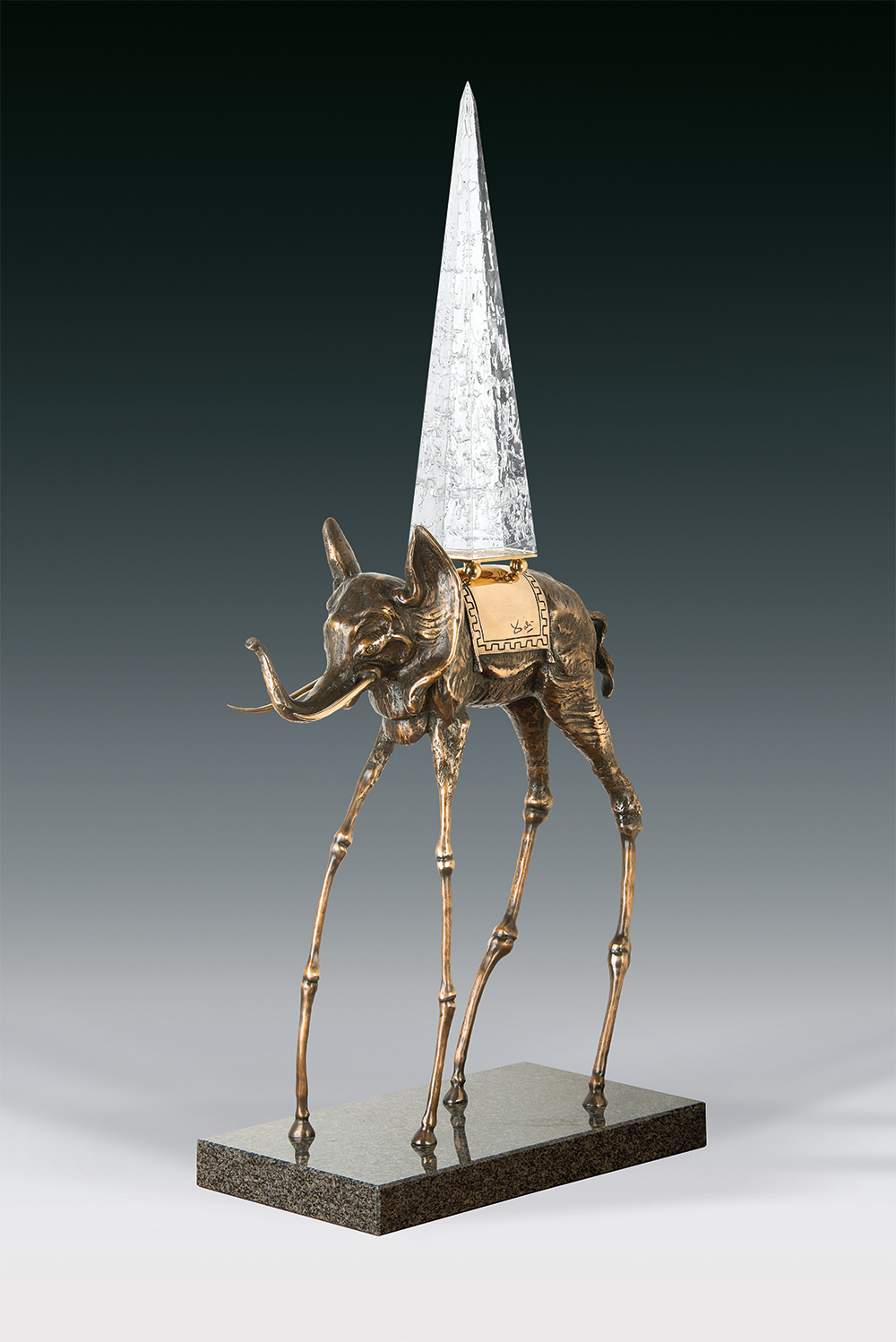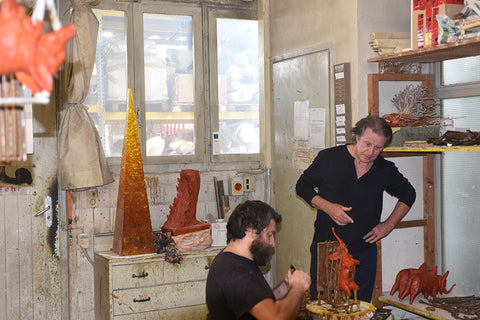Space Elephant
Bronze Sculpture by Salvador Dali
350 Limited Edition
CALL FOR PRICE
37 inches in height
Call Us | eMail Us | Live Chat
Call Us | eMail Us | Live Chat
Call Toll Free | 1.855.535.0055
eMail Us | sales@artevolution.com
Live Chat | Click on the 'Chat with us!' button on the bottom right of any page to connect with us directly.
Reviews
Reviews
To leave a review for Canada visit us at Google, Trip Advisor, Facebook or Yelp
To leave a review for Australia visit us at Google, Trip Advisor, Facebook or Yelp


Collapsible content
About this Sculpture
About
Salvador Dalí
Bio
Early Life
Salvador Dalí was born Salvador Felipe Jacinto Dalí y Domenech on May 11, 1904, in Figueres, Spain, located 16 miles from the French border in the foothills of the Pyrenees Mountains. His father, Salvador Dalí y Cusi, was a middle class lawyer and notary. Salvador's father had a strict disciplinary approach to raising children—a style of child-rearing which contrasted sharply with that of his mother, Felipa Domenech Ferres. She often indulged young Salvador in his art and early eccentricities.
It has been said that young Salvador was a precocious and intelligent child, prone to fits of anger against his parents and schoolmates. Consequently, Dalí was subjected to furious acts of cruelty by more dominant students or his father. The elder Salvador wouldn't tolerate his son's outbursts or eccentricities, and punished him severely. Their relationship deteriorated when Salvador was still young, exacerbated by competition between he and his father for Felipa's affection.
Dalí had an older brother, born nine months before him, also named Salvador, who died of gastroenteritis. Later in his life, Dalí often related the story that when he was 5 years old, his parents took him to the grave of his older brother and told him he was his brother's reincarnation. In the metaphysical prose he frequently used, Dalí recalled, "[we] resembled each other like two drops of water, but we had different reflections." He "was probably a first version of myself, but conceived too much in the absolute."
Salvador, along with his younger sister Ana Maria and his parents, often spent time at their summer home in the coastal village of Cadaques. At an early age, Salvador was producing highly sophisticated drawings, and both of his parents strongly supported his artistic talent. It was here that his parents built him an art studio before he entered art school.
Upon recognizing his immense talent, Salvador Dalí's parents sent him to drawing school at the Colegio de Hermanos Maristas and the Instituto in Figueres, Spain, in 1916. He was not a serious student, preferring to daydream in class and stand out as the class eccentric, wearing odd clothing and long hair. After that first year at art school, he discovered modern painting in Cadaques while vacationing with his family. There, he also met Ramon Pichot, a local artist who frequently visited Paris. The following year, his father organized an exhibition of Salvador's charcoal drawings in the family home. By 1919, the young artist had his first public exhibition, at the Municipal Theatre of Figueres.
In 1921, Dalí's mother, Felipa, died of breast cancer. Dalí was 16 years old at the time, and was devastated by the loss. His father married his deceased wife's sister, which did not endear the younger Dalí any closer to his father, though he respected his aunt. Father and son would battle over many different issues throughout their lives, until the elder Dalí's death.
Over the next 15 years, Dalí painted a series of 19 large canvases that included scientific, historical or religious themes. He often called this period "Nuclear Mysticism." During this time, his artwork took on a technical brilliance combining meticulous detail with fantastic and limitless imagination. He would incorporate optical illusions, holography and geometry within his paintings. Much of his work contained images depicting divine geometry, the DNA, the Hyper Cube and religious themes of Chastity.
From 1960 to 1974, Dalí dedicated much of his time to creating the Teatro-Museo Dalí (Dalí Theatre-Museum) in Figueres. The museum's building had formerly housed the Municipal Theatre of Figueres, where Dalí saw his public exhibition at the age of 14 (the original 19th century structure had been destroyed near the end of the Spanish Civil War). Located across the street from the Teatro-Museo Dalí is the Church of Sant Pere, where Dalí was baptized and received his first communion (his funeral would later be held there as well), and just three blocks away is the house where he was born.
The Teatro-Museo Dalí officially opened in 1974. The new building was formed from the ruins of the old and based on one of Dalí's designs, and is billed as the world's largest Surrealist structure, containing a series of spaces that form a single artistic object where each element is an inextricable part of the whole. The site is also known for housing the broadest range of work by the artist, from his earliest artistic experiences to works that he created during the last years of this life. Several works on permanent display were created expressly for the museum.
Also in '74, Dalí dissolved his business relationship with manager Peter Moore. As a result, all rights to his collection were sold without his permission by other business managers and he lost much of his wealth. Two wealthy American art collectors, A. Reynolds Morse and his wife, Eleanor, who had known Dalí since 1942, set up an organization called "Friends of Dalí" and a foundation to help boost the artist's finances. The organization also established the Salvador Dalí Museum in St. Petersburg, Florida.
Final Years
In 1980, Dalí was forced to retire from painting due to a motor disorder that caused permanent trembling and weakness in his hands. No longer able to hold a paint brush, he'd lost the ability to express himself the way he knew best. More tragedy struck in 1982, when Dalí's beloved wife and friend, Gala, died. The two events sent him into a deep depression. He moved to Pubol, in a castle that he had purchased and remodeled for Gala, possibly to hide from the public or, as some speculate, to die. In 1984, Dalí was severely burned in a fire. Due to his injuries, he was confined to wheelchair. Friends, patrons and fellow artists rescued him from the castle and returned him to Figueres, making him comfortable at the Teatro-Museo.
In November 1988, Salvador Dalí entered a hospital in Figueres with a failing heart. After a brief convalescence, he returned to the Teatro-Museo. On January 23, 1989, in the city of his birth, Dalí died of heart failure at the age of 84. His funeral was held at the Teatro-Museo, where he was buried in a crypt.
Photos

Alice in Wonderland and Space Elephant being polished at Perseo Foundry Switzerland

Art Evolution President Christopher Talbot at Perseo Foundry Switzerland with museum size Space Elephant Obleisk

Art Evolution President Christopher Talbot. Perseo Foundry Switzerland.

Art Evolution President Christopher Talbot. Perseo Foundry Switzerland entrance

Art Evolution President Christopher Talbot. Perseo Foundry Switzerland Space Elephant wax mould

Artisans at Perseo Foundry Switzerland

Artisans at Perseo Foundry Switzerland Space Elephant

IAR manager James Sanders, Perseo Director Andrea Ziino, Art Evolution President Christopher Talbot Perseo Foundry Switzerland
Video
Exhibitions
About the exhibition
Art Evolution is proud to work with The Dalí Universe and bring to Australia the Salvador Dalí Sculpture Collection. Dali is the most famous of all the Surrealist Artists, an iconic figure and a titan of Modern Art.
These stunning artworks are exclusively published by I.A.R. Art Resources in Switzerland. The Salvador Dalí Sculpture Collection was conceived thanks to a unique agreement made between the artist and the President of I.A.R. Art Resources, Mr. Beniamino Levi.
The Dali Universe exhibitions have been seen all over the world and have attracting over 12 million visitors over the last 40 years. The Dali Universe also owns and operates the Dalí Paris Museum in Montmartre Paris where the entire Dalí sculpture collection is on permanent display.
All Dali sculptures being exhibited are recognized in the comprehensive Dalí catalogue raisonné "The Hard and the Soft" produced by Robert and Nicholas Descharnes, which is the definitive reference book for Dalí sculpture and has 20 pages are dedicated to the entire Dalí collection.
Also on display will be original paintings by Australia’s own surrealist artist Charles Billich, who in my opinion is one of the most important living artists in the world and at age 88 is one of the most credentialed artists of all time.
Christopher Talbot
President Art Evolution.com


